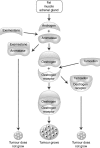Role of aromatase inhibitors in breast cancer
- PMID: 16100519
- PMCID: PMC2361691
- DOI: 10.1038/sj.bjc.6602688
Role of aromatase inhibitors in breast cancer
Abstract
Primarily, the role of the aromatase inhibitors has been investigated in postmenopausal women with breast cancer, although it is also now being assessed in premenopausal patients following ovarian ablation/suppression. Aromatase inhibitors markedly suppress endogenous oestrogens without directly interacting with oestrogen receptors, and thus have a different mechanism of action to the antioestrogen, tamoxifen. The inhibitors may be divided into subgroups according to their structure (steroidal and nonsteroidal), and there appears to be a lack of cross-resistance between the classes of aromatase inhibitors enabling them to be used sequentially and potentially to prolong endocrine hormone therapy. In addition, with increased efficacy and favourable safety and tolerability profiles, the aromatase inhibitors are starting to challenge tamoxifen as first choice endocrine treatment in a number of settings. Potential differences in side-effect profiles may appear between the steroidal and nonsteroidal aromatase inhibitors when used in long-term settings. Thus, it has been suggested that the steroidal agents have favourable end organ effects; for example, the steroidal inhibitor, exemestane, has minimal negative effects on bone and lipid metabolism in animal and clinical studies. This paper provides an overview of the current and future roles of aromatase inhibitors for breast cancer treatment.
Figures
Similar articles
-
Aromatase inhibitors for breast cancer in postmenopausal women.Oncologist. 2004;9(2):126-36. doi: 10.1634/theoncologist.9-2-126. Oncologist. 2004. PMID: 15047917 Review.
-
Exemestane: a review of its use in postmenopausal women with breast cancer.Drugs. 2009;69(7):889-918. doi: 10.2165/00003495-200969070-00007. Drugs. 2009. PMID: 19441873 Review.
-
Exemestane in postmenopausal women with early or advanced breast cancer: a review.Expert Opin Pharmacother. 2010 Aug;11(11):1933-42. doi: 10.1517/14656566.2010.495945. Expert Opin Pharmacother. 2010. PMID: 20569090 Review.
-
Drug safety evaluation of exemestane.Expert Opin Drug Saf. 2011 May;10(3):473-87. doi: 10.1517/14740338.2011.567264. Epub 2011 Mar 24. Expert Opin Drug Saf. 2011. PMID: 21428848 Review.
-
[Treatment with Aromatase Inhibitors in Postmenopausal Women with Breast Cancer and the Possibility of Influencing Side Effects].Klin Onkol. 2016 Fall;29 Suppl 3:S39-49. doi: 10.14735/amko20163S39. Klin Onkol. 2016. PMID: 28118723 Czech.
Cited by
-
Immune Checkpoint Profiles in Luminal B Breast Cancer (Alliance).J Natl Cancer Inst. 2020 Jul 1;112(7):737-746. doi: 10.1093/jnci/djz213. J Natl Cancer Inst. 2020. PMID: 31665365 Free PMC article.
-
Combinations of Calcitriol with Anticancer Treatments for Breast Cancer: An Update.Int J Mol Sci. 2021 Nov 25;22(23):12741. doi: 10.3390/ijms222312741. Int J Mol Sci. 2021. PMID: 34884550 Free PMC article. Review.
-
Palazestrant (OP-1250), A Complete Estrogen Receptor Antagonist, Inhibits Wild-type and Mutant ER-positive Breast Cancer Models as Monotherapy and in Combination.Mol Cancer Ther. 2024 Mar 4;23(3):285-300. doi: 10.1158/1535-7163.MCT-23-0351. Mol Cancer Ther. 2024. PMID: 38102750 Free PMC article.
-
Organoruthenium(II) Complexes Bearing an Aromatase Inhibitor: Synthesis, Characterization, in Vitro Biological Activity and in Vivo Toxicity in Zebrafish Embryos.Organometallics. 2019 Feb 11;38(3):702-711. doi: 10.1021/acs.organomet.8b00897. Epub 2019 Jan 31. Organometallics. 2019. PMID: 31762529 Free PMC article.
-
Clinical and sociodemographic risk factors associated with the development of second primary cancers among postmenopausal breast cancer survivors.Breast Cancer. 2023 Mar;30(2):215-225. doi: 10.1007/s12282-022-01411-8. Epub 2022 Nov 1. Breast Cancer. 2023. PMID: 36316601 Free PMC article.
References
-
- ATAC (Arimidex, Tamoxifen Alone or in Combination) Trialists’ Group (2002) Anastrozole alone or in combination with tamoxifen versus tamoxifen alone for adjuvant treatment of postmenopausal women with early breast cancer: first results of the ATAC randomised trial. Lancet 359: 2131–2139 - PubMed
-
- Baum M (1999) Use of aromatase inhibitors in the adjuvant treatment of breast cancer. Endocr Relat Cancer 6: 231–234 - PubMed
-
- Bertelli G, Garrone O, Merlano M (2002) Sequential use of aromatase inactivators and inhibitors in advanced breast cancer. Proc Am Soc Clin Oncol 21: 60a (Abstract 238)
-
- Bevilacqua G, Silingardi V, Marchetti P (2001) Exemestane for the prevention of breast cancer in postmenopausal unaffected carriers of BRACA 1/2 mutations: aromasin prevention study (ApreS). Breast Cancer Res Treat 69: 226 (Abstract 139)
Publication types
MeSH terms
Substances
LinkOut - more resources
Full Text Sources
Medical


